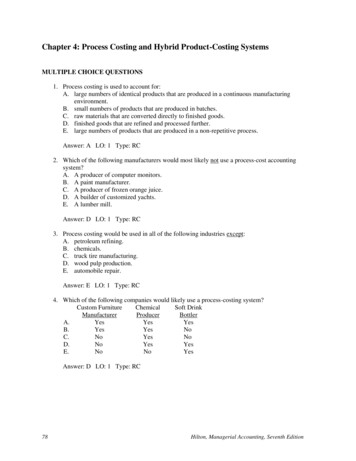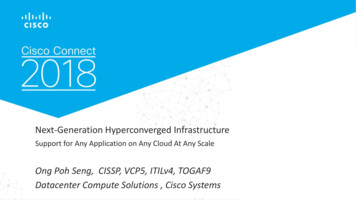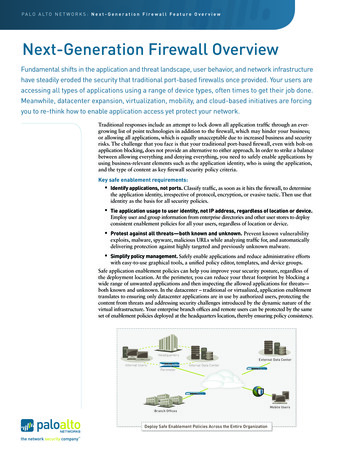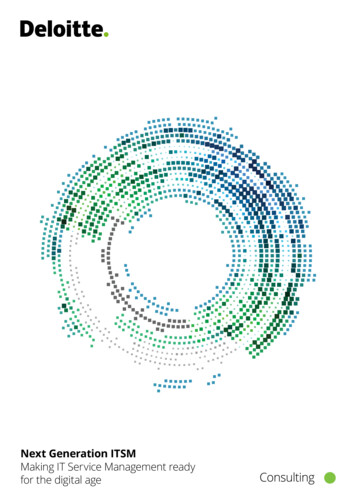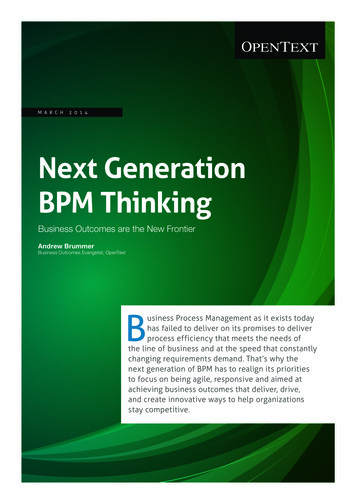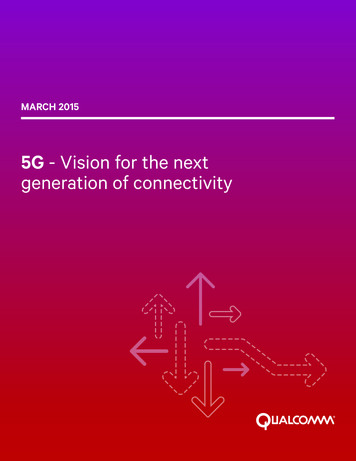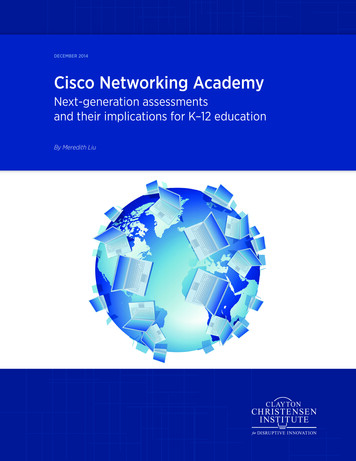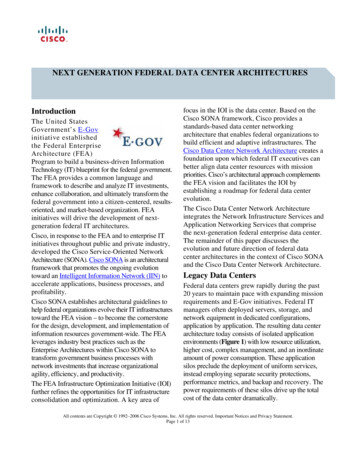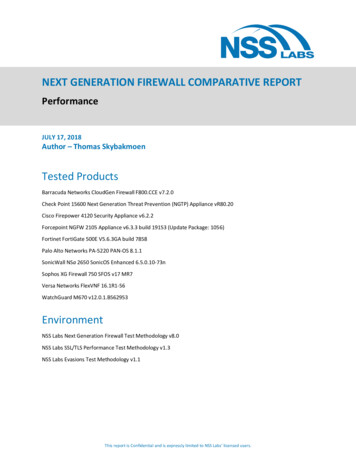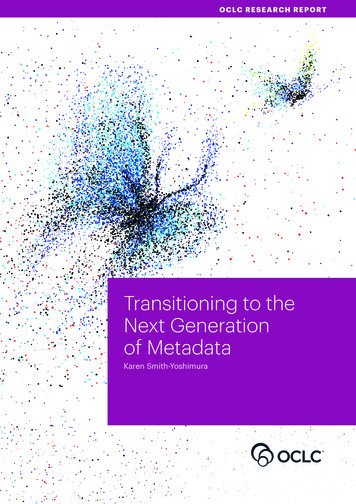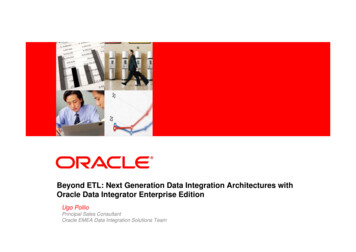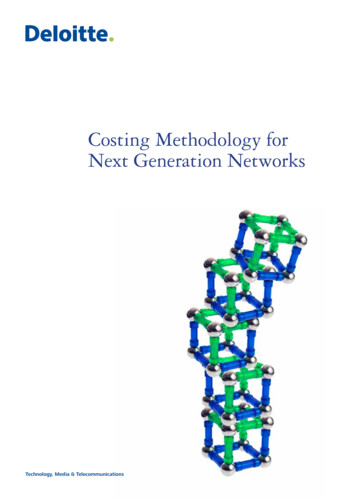
Transcription
Costing Methodology forNext Generation NetworksTechnology, Media & Telecommunications
Executive summaryLegacy, circuit-switched telecommunications networks and the newer, packet-switched networks have traditionallyoccupied different spaces within organisations, with the former used for voice traffic and the latter for data. Whilethey do share tasks, they perform, for the most part, discrete functions.But as the telecommunications ecosystem continues to develop rapidly and in particular, shift towards InternetProtocol (IP)-centric solutions for voice and video, there is now a greater need than ever for the deployment of NextGeneration Networks (NGNs). NGNs, which are packet-switched and IP-based, are able to support the convergenceof previously distinct applications, mirroring the end user experience of converged devices and services. In themeantime, however, as operators begin work on the mammoth task of building the new networks, they will have tocontend with maintaining these hybrid networks until the evolution is complete.As the telecommunications industry continues to advance at breakneck speed, its costing methodologies will need tokeep up. Originally designed based on the properties of legacy networks, price regulations for monopolistic serviceshave generally utilised cost models adopting various costing methodologies. The increasing deployment of IP-basedfixed and mobile infrastructure in combination with the still unanswered search for data monetisation have intensifiedthe pressure on the industry to review its costing methodologies for both regulatory and commercial cost analyses.This paper discusses the general concept of costing for telecommunications services, the challenges faced byoperators and regulations with the introduction of NGNs, as well as the implications of NGN on traditional costingmethods.3
The need for a dedicated costmodel for NGNTraditional telecommunications cost modelsTraditionally, cost models were tools used byregulators to monitor and control prices for accessand interconnection services which are monopolisticin nature. Over time, operators have also developedcost models to analyse their own cost structures forregulatory and business purposes. With developmentsin new technology, services and regulations, costmodels have gradually evolved to reflect these changes.At present, the capabilities of cost models haveexpanded and can be used for regulatory pricing (tariffregulations), profitability analysis (pricing strategies),regulatory accounting (accounting separation), and costoptimisation, amongst other purposes. Fully Allocated Cost (FAC): All costs are consideredand allocated to all services provided by the network;this approach is commonly used in conjunction witha top-down model. Resulting costs for services will bethe highest possible and provide an indication of thecost ceiling.Types of cost modelsTelecommunication networks are capital-intensive andinvolve shared platforms and systems that supportmultiple services. As a result, numerous cost modelsexist and the treatment of such costs will need to bedefined. The three main models are:Between the FAC and LRIC models, there are variationsof LRIC, mostly relating to differences in the inclusionor exclusion of certains costs and treatment of commoncosts, with their specific uses dictated by circumstances.A summary of the different methodologies and theircorresponding inclusion of cost types is illustrated inFigure 1. Long Run Incremental Cost (LRIC): With the LRIC,only incremental costs and/or service-specific fixedcosts are allocated to services. If joint and commoncosts are allocated through mark-ups, the LRICmethod will begin to resemble FAC. Resulting costsfor services will be minimal and provide an indicationof the cost floor. Standalone Cost: This approach is used when themodelled network is providing only a single serviceand thus all costs (service-specific, joint, and commoncosts) are allocated to a single service.Long Run Incremental Cost (LRIC)Total Service Long Run IncrementalCost (TSLRIC) / Long Run AverageIncremental Cost (LRAIC)Total Element Long RunIncremental Cost (TELRIC)TELRIC uniform mark-up*IncrementalcostIncrementalService-specific costfixed costIncrementalcost Allocation of part ofService-specific joint and common costfixed costIncrementalAllocation of part ofAllocation of residual ofService-specific costjoint and common costjoint and common costfixed costTSLRIC / LRAICIncrementalcost Fully Distributed Cost (FDC) /Fully Allocated Cost (FAC)*Incrementalcost Service-specific FAC-based allocation of all joint and common costfixed costStandalone CostIncrementalcost Service-specific fixed costService-specific fixed costAllocation of all joint and common costAll joint and common costNotes: In this example, FDC/FAC is assumed to be calculated based on forward-looking economic cost methodology. The total costs of the three cost concepts identified by an asterisk, *, do not necessarily have to be equal, as shown in this example. The relative sizes of the costing concepts are indicative only and should not be taken as an approximation of actual costs.Figure 1: Cost methodologies and corresponding cost types (Source: International Telecommunications Union)4
Globally, and especially in the European Union, there has beena marked shift from FAC to LRIC as the costing standard fortelecommunication services. Regulators using LRIC cost modelsto regulate prices for services (e.g. Mobile Termination Rate(MTR), Roaming, Interconnection (IC), Local Loop Unbundling (LLU))would consider only the incremental or marginal costs incurred by theoperators, and thus the prices would be lower relative to the FAC model.NGN and the key differences from legacy networksNGN has been defined by the International TelecommunicationUnion as “a packet-based network able to provide servicesincluding Telecommunication Services and able to make use ofmultiple broadband, quality of service (QoS)-enabled transporttechnologies and in which service-related functions areindependent from underlying transport-related technologies1.”It is an IP-based network with a multi-layer architecture forservices, control, transport, and access. Traditional switches arereplaced by media gateways and soft switches.In traditional legacy networks, each service is operated on its owndedicated network – fixed line telephony on public switched telephonenetworks (PSTNs), mobile voice services on mobile networks, televisionbroadcasting on satellite and cable networks, etc. These networks aredesigned independently and specifically for a single service.NGN offers services independent of the type of network because itis a converged multi-service network, as illustrated in Figure 2. Thesedifferences will impact current cost modelling methodologies.Traditional legacy networksNext Generation NetworksServicesContentContentMobilenetworkCable rkIP / Ethernetbackbone networkDatanetworkMobilenetworkCoaxialnetworkFibre / coppernetworkFigure 2: Architectural differences between traditional legacy networks and Next Generation Networks1NGN Working Definition, International Telecommunication Union (2004)5
Creating a successful NGN cost modelExisting costing approaches and methodologies havebeen designed based on the characteristics of legacynetworks and thus are effective when used to modelcosts of legacy networks. The emergence of NGNs,however, presents a new set of considerations fortelecommunications companies as it is much moredifficult to apply the traditional cost causality principles.NGNs can have significant impacts on the traditionalcosting models, including cost allocation, treatment ofincremental costs, and regulations based on LRIC.Network utilisation routing table no longersufficient for cost allocationAs multi-service platforms, NGN networks wouldhave much higher fixed shared and/or common costsas compared to legacy networks. Consequently, aneffective cost allocation method of services is required.In traditional cost models for circuit-switched networks,cost allocation to services was commonly performedthrough a network utilisation routing table. Networkrouting scenarios were defined for each particularservice using the principle of cost causality and costshave been allocated via degree of utilisation of networkelements to their corresponding services.An NGN network, as an integrated packet-switchednetwork, is capable of handling a wide range of traffictypes, each with its own service quality requirements.Service quality is a more complex concept in a packetswitched network and involves a number of criteria suchas bandwidth, delay, jitter, packet loss, and blockingprobabilities. Consequently, network utilisation routingtables are no longer sufficient to determine the amountof capacity required to meet a given service qualitystandard. To do this, bandwidth pattern information ofservices on an NGN network would be required.26Davies, Hardt, Kelly – Network Dimensioning, Service Costing and Pricing in a Packet Switched EnvironmentA new approachFor an NGN network, a new approach is required toquantify the relationship between traffic volumes,service quality, and capacity to determine the coststhat are causally attributable to the various services in amulti-service, packet-based environment2.For IP-based services on packet-switched networks, aQoS routing algorithm, that is, one that allocates costsby QoS to services, is preferable as QoS is correlatedwith bandwidth requirements. The bandwidth usage inone-hour intervals (preferably within at least a 12-hourtimeframe) for each modelled service is required.A sample of the hourly bandwidth utilisation is given inFigure 3. Based on this value, the cost of each modelledservice will be distributed based on the weighting ofthe bandwidth demand by each service, as illustrated inFigure 4.
Bandwidth pattern :00Service A6:007:008:00Service B9:0010:0011:0012:00Service CFigure 3: Hourly bandwidth utilisation pattern for sample servicesService unit cost (US vice AService BServiceCost share(%)Service A14.701.45Service B22.05Service C63.26Total cost of service(US )Service CPeak bandwidth(MBps)Service unit cost(US /MBps)3.000.482.185.000.446.2610.000.63Figure 4: Sample results from a cost allocation by QoS exercise7
Treatment of legacy costs during migration toNGNAs NGN network deployment involves new investmentswith no historical accounts, valuation of assets willfollow a current cost accounting (CCA) approach,usually with the use of the Modern Equivalent Asset(MEA) method. The MEA method is the standardapproach to asset valuation in a situation where therehas been a change in technology (resulting in significantimprovements in productive efficiency, functionality oroperating cost reductions, for example) and the asset inuse cannot be purchased in the form currently utilisedby the operator.If existing assets cannot be replaced in an identical form,the replacement costs of a particular item can be basedon the cost of a modern equivalent asset. By using theMEA method, the new investments would be valuatedaccording to their actual purchase price or current cost.Dealing with “cost hump”During actual NGN deployment, operators willexperience a phase where they are building newnetworks whilst maintaining existing ones until theevolution completes. This hybrid period could also implya “cost hump” for operators.The use of MEA with NGN costing must be donewith great care, and other alternative asset valuationmethods such as indexation, absolute valuation, andappraisals may be considered. Striking the right balancebetween costing historical and future investments isessential, and this should be done in consideration ofthe operators’ business and the regulator’s objectives.Regulating prices based on LRICLRIC is typically used to regulate the prices of wholesale(interconnection and access) voice services. Theincremental or marginal cost of increasing voice volumesis used to set interconnection and access rates. NGNnetworks have extremely large capacities of networkelements as compared to traditional legacy networks.As a result, the incremental or marginal cost for traffic inan NGN network can be close to zero. This is illustratedin Figure 5.A solution to overcome the differences in incrementalcost between the two types of networks is to defineprecisely the increments in LRIC. For NGN networks, theincrement has to be larger to reflect the large additionalcapacities of the network. With a larger increment, thepricing of services based on incremental cost can againbe established.Using MEA to valuate the legacy network would ignorea majority of the costs and thus past investments wouldnot be recovered. If regulators base price regulationson such methods and operators are not allowed torecover historic investments, incentives to invest in newinfrastructure would be reduced.Traditional legacy networksTrafficNext Generation NetworksTrafficSmall incrementCostLarge incrementCostFigure 5: Differences in LRIC for traditional legacy networks and Next Generation Networks8
ConclusionWith increasing deployment of NGNs leading to thecoexistence with – and, eventually, the replacementof – legacy networks, the impacts of NGNs can nolonger be overlooked. Price regulations have generallyutilised cost models based on methodologies designedon the properties of legacy networks. The developmentof NGNs means that these traditional cost modelswill need to be reconsidered in light of its differenceswith legacy networks. Three main areas are impactedand this is evident in the application of traditional costmethodologies to NGN: cost allocation; treatment ofcosts; and regulations based on LRIC.Cost allocation for NGN and IP-based networks shouldreflect the relationship between traffic volumes, servicequality, and capa
Types of cost models Telecommunication networks are capital-intensive and involve shared platforms and systems that support multiple services. As a result, numerous cost models exist and the treatment of such costs will need to be defined. The three main models are: Standalone Cost: This approach is used when the modelled network is providing only a single service and thus all costs .
